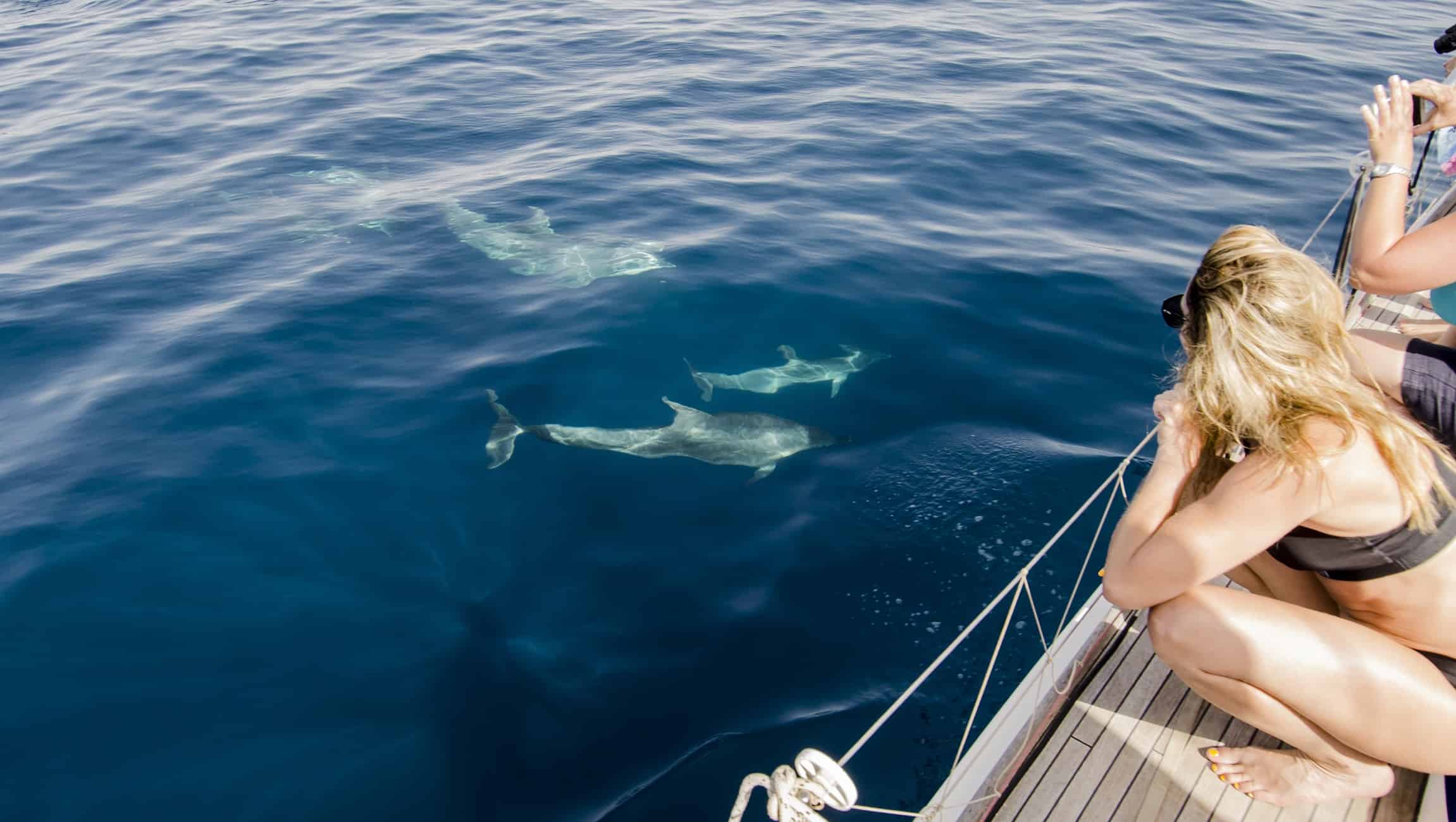
CAPTAIN JUSTIN SMITH SLOWS the cruise boat, called the Getaway, just a short distance from the dock on the southern end of South Padre Island, and points out two dorsal fins.
It seems you don’t have to go far in Laguna Madre Bay’s nutrient-rich waters along Texas’ western Gulf Coast to spy marine life. He’s spotted two bottlenose dolphins swimming near the bow, making our Dolphin Watch and Eco Tour a success five minutes into the 90-minute cruise.
“You can never predict for certain you’ll see them, but chances are good here,” says Smith, an experienced marine captain originally from southern Florida.
On this day, the dolphins keep their distance and this being an eco-tour, there’s no attempt to bribe the dolphins closer to us. They’re protected by the U.S. federal government, meaning feeding wild dolphins is against the law – which is how the crew of Breakaway Cruises like it.
Deckhand John Delgato says there’s no need to feed dolphins since food is so plentiful here. He also abhors the tourist attraction of swimming with dolphins commonly seen in places like Florida, Mexico and the Caribbean.
“We want our dolphins to stay wild,” says Delgato. “Why on Earth would you want to swim with them? They have teeth and can bite chunks off of you.”
 South Padre Island CVB
South Padre Island CVB
The dolphins around South Padre Island have adapted to the shallow waters of the 209-kilometre-long lagoon they inhabit, so they are smaller than dolphins living further offshore in the Gulf of Mexico. (The Laguna Madre has an average depth of 0.7 metres and is not deeper than 1.5 metres.) Further out in the Gulf of Mexico, dolphins can reach four metres in length – double the size of their inshore counterparts.
Smith says there’s a resident pod of dolphins that tend to hang around the rock jetties at the southernmost tip of South Padre Island, so we head there.
We float just off the rock jetties, not far from the first causeway linking South Padre Island to the mainland, built in 1953. Its central span is long gone and the newer four-kilometre-long Queen Isabella Causeway, completed in 1974, is behind us. Its flashing signs warning drivers about passing pelicans. Like the dolphins, they too are plentiful in this area because of the abundance of fish, shrimp and squid.
Smith suddenly lets out a whistle and waits. No response from the dolphins. He tells me he is hoping members of the resident pod will come to recognize his whistle and pop up so guests on board can see them.
“It works for another captain; except he blasts 80s heavy metal music. They seem to like that,” he says.
Delgato adds sometimes the dolphins just want to be left alone and other times they are in a playful, if not a mischievous mood.
“I’m pretty sure they mess with Justin (Smith),” said Delgato. “They once lead him into shallow waters and got us stuck.”
ON THIS CRUISE WE VIEW about a dozen dolphins, but none remain at the surface long enough for any good, close-up pictures. The best I can manage are brief video clips of fins that emerge momentarily and are gone just as quickly. That’s fine by me since I’m also a strong believer in sustainable tourism, which is all about having as low an impact as possible on natural environments.
So, it’s with some trepidation that I watch as Delgato pulls out a drag net, throws it overboard, allowing it to comb the bottom of the lagoon for a short distance. There’s a large container of seawater on board awaiting the marine life to come. We’re warned beforehand not to put our hands in the tank, since you never know what will be pulled aboard.
 Kim Pemberton
Kim Pemberton
“I once caught a butterfly ray in the drag net and a sting ray and got stung. I didn’t feel my arm for the rest of the trip,” says Delgato. “I also got stung by two jellyfish twice that day – it wasn’t a good day. Now I’m used to a jellyfish sting. It’s just like a mosquito bite to me.”
I watch as Delgato untangles the sea life caught in the net and then quickly transfers the critters to the container. I happen to be sitting directly behind it and my vantage point provides me with an ideal viewing spot.
It seems our “eco-net presentation” has garnered two small puffer fish (one with a broken tooth), two starfish, one tiny hermit crab and one average size shrimp – along with lots of seaweed and an empty can of beer.
Delgato says they want to keep the marine life as calm as possible which is why they are viewed (mostly) in the container. He provides facts about each and at the end of his talk he offers guests the opportunity to touch each before tossing it carefully back into the water. They are back in the bay within 20 minutes.
 South Padre Island CVB
South Padre Island CVB
While I was initially unsure of the presentation, in the end, I did learn more from this close-up encounter than I expected. I was most interested to learn that shrimp boats can remain in the Gulf of Mexico for as long as 45 days at a time. It was with a degree of pescatarian guilt that I inspected the one average size shrimp up close which looked very much alive. While happy to see the shrimp tossed back into the lagoon, I have to admit the jury is still out on going full vegetarian.



